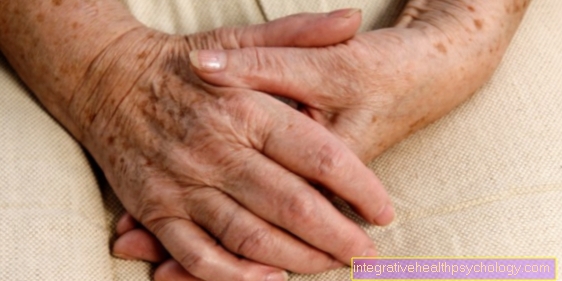Skin cancer on the face
definition

Skin cancer is a collective term for numerous cancers that develop or are visible on the skin. The most feared skin cancer is black skin cancer, known as malignant melanoma. It arises from the pigment cells of the skin, which is why it is usually black in color. Much more common, on the other hand, is white skin cancer, which includes basal cell carcinoma and squamous cell carcinoma and their precursors (e.g. actinic keratoses).
White skin cancer primarily affects the elderly and tends to affect the upper layers of the skin. Squamous cell carcinoma occurs primarily on the face, as it is caused by long-term exposure to the sun. In particular, the so-called "sun terraces" on the face, the auricles, the bridge of the nose, the eyelids and the lower lip, which are exposed to particularly high levels of solar radiation, are affected.
There are also a number of other skin cancers, some of which are very rare, but cancers of internal organs can also settle in the skin and lead to malignant changes.
You may also be interested in this article: White Skin Cancer
Symptoms of skin cancer on the face
The symptoms associated with skin cancer on the face depend on the type of skin change. Black skin cancer does not initially cause any symptoms, it is characterized by mole-like dark, black spots on the skin. Usually the spots are asymmetrical, irregularly limited, large and unevenly colored.
Basalioma or basal cell cancer grows slowly, visibly, usually painlessly and predominantly appears as a skin-colored or reddish nodular skin change. Actinic keratosis is particularly evident on the face as it occurs on areas of the skin that have been exposed to frequent sunlight. Small reddish, rough spots appear, which can also be accompanied by itching.
Read more on the subject at: Symptoms of skin cancer
Causes of skin cancer on the face
As with all cancers, it is likely that a variety of factors lead to the development of skin cancer of the face. The best known and most easily influenced risk factor is UV radiation from the sun and solariums. The skin on the face in particular is very often exposed to UV radiation, which results in damage to the genetic material (DNA). This damage changes (mutates) certain genes that are crucial for the development of cancer.
The fact that the skin of the white population is particularly unprotected against UV radiation is shown by the fact that sunburn sets in after a few minutes to hours of exposure to the sun. The severe damage to the genetic material of the skin cells leads to programmed cell death of the affected cells. Sunburn occurs with blistering, flaking and subsequent renewal of the skin.
Light skin and frequent sunburn are therefore among the strongest risk factors for skin cancer on the face. But the total number of liver spots on the body also plays a role; anyone who has more than 50 to 100 liver spots has an increased risk of black skin cancer.
Therapy of skin cancer on the face
The preferred treatment for almost all skin cancers on the face is surgical removal of the lesion. Some skin changes can also be frozen (cryotherapy). When skin cancer on the face is surgically removed (excision), a safety margin must usually be maintained, which means that healthy-looking tissue around the malignant skin lesion is also removed. In the case of black skin cancer, the so-called guardian lymph node (the lymph node closest to the skin cancer) may also have to be removed, since the malignant melanoma is usually the first to settle (metastasize). For larger black skin cancer changes on the face, treatment usually follows after the surgical removal, for example certain drugs are injected under the skin for a while after the operation in order to combat any individual tumor cells that may have remained.
Surgical intervention on the face in particular has cosmetic consequences due to the scarring, which is why alternative treatment methods are often tried first, depending on the type of skin cancer present. For example, actinic keratosis is treated with creams that contain active ingredients such as diclofenac or imiquimod.
diagnosis
In all types of skin cancer, this is the main factor early detection an important role. If a malignant skin lesion on the face is detected at an early stage, it can often be treated and cured well. Above all, the self-examination is crucial. Particular attention should be paid to everything on the skin new emerges or yourself changed.
Suspicious skin changes can be detected using the ABCD-Rule to be assessed: A.symmetry for asymmetrical changes in their shape, B.delimitation for irregular or blurred spots, C.olor (color) for changes that have different hues and D.diameter for patches of skin that have a diameter exceed 5 millimeters. If a skin lesion on the face meets these criteria, a dermatologist should conduct further tests to determine whether the lesion is benign or malignant.
forecast
Skin cancer is a disease in which the tumors spread over time, which is why treatment is essential. The chances of a cure for black skin cancer depend on how early the change is recognized and treated: the sooner the better. Of the Basal cell cancer can usually and can be treated well in over 90 percent of the cases are cured.
The actinic keratosis should be treated as a precancerous stage, as it progresses to squamous cell carcinoma in about 10 percent of cases. Overall, there has been great progress in the treatment of skin cancer, but the most important measure for a good prognosis remains the avoidance of strong sunlight and the early detection of skin changes.
prophylaxis
prevention is the most important and most effective method of preventing skin cancer on the face from developing in the first place. The face is not covered by clothing and therefore the part of the body that is most exposed to the sun. White skin cancer in particular occurs on the face in older people, as many years of harmful UV radiation lead to irreparable damage to the genetic make-up. The most important measure to prevent skin cancer on the face is that Avoidance of excessive sun exposure in the hours of the greatest intensity of radiation. Wearing shady headgear and protection with sunscreen makes sense and should be done consistently.Sunburns on the face must be avoided at all costs and solariums should not be used as a matter of principle.
All legally insured have from 35 years of age every 2 years entitlement to a so-called Skin cancer screening, in which a qualified doctor examines the entire skin of the body for skin cancer in order to identify and treat possible malignant changes at an early stage.





.jpg)






















